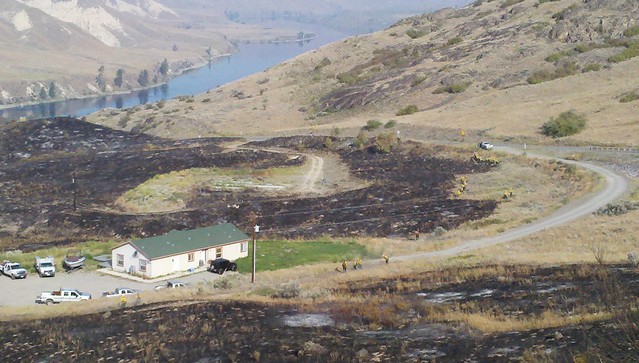
Fire seasons have lengthened so much that we now use the term fire year, firefighting costs are breaking new records, and loss of life and property are part of an alarming new pattern. The ability to mitigate these impacts with community collaboration is critically important.
Several groups are taking a hard look at the rising costs of fighting wildfire versus the benefits of mitigation investments before the flames arrive. Studies like the Tale of Two Fires and True Cost of Wildfires (PDF, 911 KB) illustrate a cost–benefit ratio as high as $5 saved for every $1 spent on fuels treatments.
In recent years, several examples of community mitigation efforts have emerged to demonstrate the tradeoff values of doing work before the fire, across property boundaries and within communities. One of these examples is the Timber Crater 6 fire near Crater Lake, Oregon. A series of dry lightning storms passed through the Cascade Mountains in July 2018 and started the fire.
The potential destructive path of this fire included over 20,000 acres of the Crater Lake recreation area, and several small, neighboring communities. But existing fuels treatments on federal and private lands helped fire managers prevent large-scale destruction and minimize the threat to the public. In the end, not a single structure was lost, and the fire was contained at 3,126 acres.
The key to community mitigation efforts is more than fuels treatments on federal lands. Collaborating with state cooperators, non-federal partners, and private citizens is where the true success of fire-adapted communities begins.
Many states provide homeowners with matching funds for defensible space projects and other fuel reduction efforts. The Forest Service, National Fire Protection Association, and the Insurance Institute for Business and Home Safety provide this handy homeowner tip sheet to prepare residents for the wind-blown embers responsible for destroying most homes regardless of surrounding fuels work.
In response to the 2015 wildfire season, the Forest Service created a Community Mitigation Assessment Team program to work with communities and partners who are motivated to address both the immediate home ignition zone and forested lands in surrounding areas.
CMAT teams help communities build sustainable local capacity for wildfire mitigation during high-risk times before, during or after a wildfire when awareness of the need for risk reduction and the likelihood of action is highest. CMAT works collaboratively with communities to build cross-boundary mitigation partnerships that focus on reducing risk strategically.
The team integrates community fire adaptation best practices and resilient landscapes concepts outlined in the National Cohesive Wildland Fire Management Strategy.
Lastly, since wildfire does not recognize property boundaries, the Forest Service has worked to create resilience within communities by providing training, information and opportunities. Promoting Ecosystem Resilience and Fire Adapted Communities Together, or PERFACT (PDF, 1 MB), is addressing the country’s wildfire problems head on by supporting the people who are creating change on the ground. This work empowers local people to navigate their own pathway toward a better relationship with fire.
The intent is to connect them with other people, programs, tools and ideas that they can adapt and use to help their communities live better with fire. This program works with people over a period of several years, making small, sustained investments as they tackle their challenges.
The investments we make today are paying large dividends on the landscapes of tomorrow.

